

Halfpenny.
These occur of the dates 1770 to 1775 inclusive. There is a halfpenny of 1772 (now very rare), on which the
king's name is spelt GEORIVS, but it was suppressed, and a coin with the name of the king correctly spelt, was issued
in its stead.
Similar pieces, bearing the date 1773, which though struck are evidently forgeries, are in the cabines of Mr. G. D.
Brown and Mr. Hoblyn. The former was in the Bergne Collection (Lot 1141). Silver, gilded and bronzed copper proofs
exist of the halfpenny of 1770, of which the workmanship is very fine.
Farthing
These were coined in 1771, 1773, 1774 and 1775 only. The farthing of 1772 has been said to exist, but I doubt it.
Christmas questions the year 1775, and states that the farthing of that year was probably a forgery; but although
forgeries of this coinage are as plentiful as those of the preceding monarch, and I have seen them more often
(especially the halfpennies) of the year in question, I have had a farthing of 1775 which is undoubtedly genuine.
There is one equally beyond suspicion in the National Collection, and doubtless in many other cabinets.
Proofs of the farthing of 1771 occur in bronzed copper. The head on this coinage were probably engraved by Tanner
whose work they closely resemble and the reverses were from the old dies of George II., which were also engraved by
that artist. After 1775 there was a long gap, apatterns, which will be treated of under that head, were struck, but
no coins were issued for currency until the year 1797, which a large coinage, designed by Kü, of what are now
popularly called the "cart-wheel" pieces, took place.
Twopence.
This is the first and last twopenny piece that was ever coined by authority in copper. The word SOHO
refers to the Soho Mint at Birmingham, where Messrs. Boulton & Co. carried on their business, and coined these and most
of the copper coins and patterns of this reign. There is a variety without the dot after REX.
Proofs occur in gold, silver, and gilded bronze, bronze and copper.
Penny.
Proofs occur in gold, silver, gilded bronze, bronze, copper and tin.
The halfpenny and farthing of this year were never issued for circulation, and should properly, therefore, be treated
as patterns, but to preserve the continuity of the series, it will be more convenient to describe them here.
Halfpenny.
This occurs in gold, silver, gilt and bronzed metal. In some specimens of the latter the edge is slightly grained, but not
to the extreme edge of the coin.
Farthing.
This occurs in gold, silver, gilt and bronzed or yellow bronze metal. I have had a silver pattern which differs in wanting
the word SOHO on the reverse and also in the form of the ship; the prongs of the trident are also much larger.
The farthing of 1798 is a pattern and will be described under that head. In the year 1799 a halfpenny and a farthing
were struck for circulation. They also have edges grained as on No. 5. On these coins the broad band and sunk letters
are discontinued.
Halfpenny.
Gilt proofs occur, as also proofs in copper and bronze. The proofs differ from the current piece in having a small
K followed by a pellet on the truncation under the King's shoulder, or very rarely by three pellets
horizontally placed in that position. A gilt bronze proof also occurs with K of a script character, followed
by three pellets on the truncation of the king's shoulder and with a dot after III. and REX.
Farthing.
Gilt proofs, as also proofs in bronze and copper, occur. A gold proof with plain edge was included in the sale of the
collection of Mr. John Marshall, of Belmont (Lot 66), and a silver proof was in my own collection.
In 1806 and 1807 a very extensive issue of copper coins took place consisting of the penny, halfpenny and farthing.
This was sufficiently large to cause the gradual disappearance of the numerous tradesmen's tokens with which the kingdom
warmed, and which had become necessary and in general use previously, owing tot he great scarcity of current coins.
Penny.
The dates are 1806 and 1807. A proof occurs, struck in tin, with the obverse of the Irish penny of 1805, and the reverse
of the English penny of 1806. It was probably a first pattern for the new English coinage.
Halfpenny.
Farthing.
The edges of these pieces of 1806 and 1807 are slightly grained, the graining, however, not extending to the actual edge of
the coin.
Proofs of the above three coins of 1806 occur in silver, bronze, gilt bronze and copper, and of the farthing also in
gold. The silver and gold proofs are excessively rare.
Bronze proofs of the halfpenny and farthing of 1807 with plain edges were formerly in my collection; but they appear
to have been struck from worn dies, subsequently repaired.
PATTERNS.
This is with a plain edge and is bronzed, and was probably the first essay on the part of Droz, whose French proclivities
as displayed thereon, were probably not appreciated nor likely to be adopted by his patriotic employer. A genuinely
struck specimen of this was in the cabinet of Mr. W. Brice. I have also seen modern-struck examples.
The edge of this pattern is sometimes plain and sometimes of guilloche pattern finely grained on either side. It occurs
in bronze, gilt bronze, bright copper and silver plated.
The employment of the French mode of spelling CAESAR is quite in keeping with the adjunct of the eagle's
head before mentioned, as well as with the Bourbon features given by this talented, but erratic, artist to the king's
head, on all the patterns of this series.
This pattern occurs in copper, bronze and gilt bronze, and is sometimes silver plated.
Examples in copper and bronzed copper occur. The die was probably altered from that of No. 1, and has evidently been
"touched up." An example in the collection of Mr. Caldecott has an engrailed edge.
A copper proof of this with a plain edge was in the cabinet of Mr. W. Brice.
The edge is sometimes plain and sometimes of the guilloche pattern. This piece occurs in copper which is sometimes
bronzed or gilt.
One variety occurs with the king's hair more flowing and with no letters on the truncation or under the bust, and on this
variety the words are separated by points only. The reverse is as No. 6.
The V on the pieces of 1790 is substituted for the U on those of 1788.
This pattern occurs in silver, bronze and gilt bronze. In one scarce variety the letters on the edge are sunk.
Another variety occurs in bronze, which is a "mule" with the obverse of the Bermuda halfpenny of 1793. This must,
naturally, have been a "re-strike."
This occurs in bronze and silver, and differs from all the other patterns of 1788 and 1790, in having the words on the
obverse divided by small quatrefoils. In those previously described except the variety of No. 6, the division is effected
by small lozenges. Mr. W. Brice had an unique specimen in gold of this type, but with the edge inscribed RENDER &C.
Mr. G. D. Brown has a halfpenny with the obverse of No. 8, but with the reverse of No. 1. Mr. Maish has a similar piece
of abnormally heavy weight dated 1788. It has a guilloche edge and a worn and cast appearance, and is probably a concoction.
There is a bronze halfpenny by Droz, with DROZ. F. under the bust and the inscription on the obverse as
usual, but with a nude figure of Britannia on the reverse, similar to Droz's usual work, except that behind the shield
there is no laurel branch, but a large paddle which the figure clasps in her left hand. There is no legend on the reverse,
and the edge of the coin is plain. All specimens of this in bronze which I have seen are (with the exception of one in the
National Collection with the obverse incluse) of modern striking; but I find that so far back as the 24th April, 1852, one
was exhibited at a meeting of the Numismatic Society. I had a silver piece, apparently a genuine and contemporaneous coin,
which has the nude figure on one side, and on the other the same figure draped and the shield properly displayed, and upon
the paddle is depicted a dolphin and trident. The word DROZ. is under the feet of Britannia, and beneath the
date is DROZ. INV. Mr. Hoblyn has this in gilt bronze.
The next patterns are those by Lewis Pingo in bronzed copper, with the edges sometimes plain and sometimes coarsely grained.
Penny.
Halfpenny.
There were apparently more than one die engraved and used for this pattern, as on one halfpenny with a plain edge the work,
including the lettering, is finer than usual; there are no dots between the words on the obverse, and the figures of the
date are more widely separated, and on the reverse a dot occurs after BRITANNIA, which is wanting on the
ordinary type.
These patterns have generally a plain edge but very rare examples occur with the edge roughly grained. It is possible that
instead of being patterns for a penny and a halfpenny they were designs for a halfpenny and a farthing. Mr. Barré Roberts,
in his Manuscript Catalogue, states them to be "of remarkably inferior workmanship, engaved by L. Pingo and presented by the
Mint Officers at the same time with Mr. Boulton's beautiful specimens by Droz."
In the same year were struck the following patterns by Mr. Moore, Secretary to the Society for the Encouragement of Arts,
&c., which were engraved by Hancock. The design no having been approved, very few were struck.
The edge sometimes occurs grained and sometimes of guilloche pattern. A specimen with the latter edge, was in the cabinet
of Mr. W. Brice, and Mr. Hoblyn has a similar coin in gilt copper. A silver proof of this pattern is in the National
Collection, with the inscription ARMIS., &C., on the edge.
This occurs in copper.
14. There is another pattern which was struck, in bronzed copper, at Birmingham (probably at Mr. Moore's instance, by
Hancock), and which is evidently intended for a halfpenny. It has a similar bust and inscription on the obverse, except
that a curl appears in front of the neck, and on the reverse there is no design, but the word VIVAT! is
engaved across the field of the piece. The inscription ARMIS. TVTERIS. MORIBVS. ORNES. also
occurs on the edge. Examples in silver are known. R. 5.
In the National and other collections is a pattern, probably for a halfpenny.
The king's bust is apparently of French design, resembling that by Droz, and the work is fine.
The next patterns were those which introduced a new feature into the coinage of this reign, viz., the raised band with the
legend in sunk letters. This was adopted on the current pieces of 1797, and was considered to be likely to preserve the
coin, and especially the central portion, from wear. It, however, answered this purpose very imperfectly. The earliest
pattern presenting this peculiarity was a halfpenny which proceeded from the Soho Mint.
This occurs in bronzed and gilt copper, but I have had a silver proof.
In my own collection is an example in silver of this variety.
There are several patterns of pieces of 1797 of the same series, all issuing out of the Soho Mint, and which I now describe.
Penny.
A dot should follow BRITANNIA in the engraving.
The lettering on the above is large, and specimens occur in silver (thick and thin flans), bronze, and in gilt bronze.
I have had a variety in silver which has SOHO instead of K. under the rock. It may be
mentioned here that the K. for Küchler has most often, though not always, before or behind it in these
and other coins by the same artist, three small pellets arranged triangularly, by way, no doubt, of a privy mark. In
many of the re-strikes of which my silver variety was probably one, the letter K is supplanted by
SOHO.
This, which is very rare, occurs in copper and bronzed copper.
The next patterns have the figure of Britannia helmeted, and are by the same artist.
Penny.
This occurs in copper and in tin. A variety, perhaps a re-strike, occurs on which the head and helmet are somewhat
larger and more elaborate, the drapery extends further across the globe, which rests on the ground instead of being
above it as in No. 21, and the feet of Britannia are on the ground, so that the rocks cannot be seen beneath them.
A specimen of this in silver was in my own collection.
This occurs in bronzed copper and gilt bronze, and is very rare. It is sometimes struck on a thick and sometimes on a thin
flan.
An example, in copper, is in the collection of Mr. Caldecott. I have not seen it elsewhere.
The only specimen of the above that I have seen has the appearance of being a re-strike, and is perhaps a concoction by
those whose operations will be hereafter referred to.
The following three coins are treated by some collectors as private tokens only. It is possible that they were struck as
standard patterns for general use, and as some slight evidence of this, the halfpenny occurs not only with a plain edge
but sometimes also with the inscription PAYABLE AT CRONEBANE LODGE OR IN DVBLIN. The obverse somewhat
resembles the work of Droz, but the pieces were engraved by Westwood, of Birmingham, whose intiial W occurs
in the exergue of the farthing.
Penny.
This occurs in bronzed copper.
Halfpenny.
This occurs in bronzed copper also. In addition to a bronzed specimen with the edge inscribed PAYABLE, &C.,
as before mentioned, I have had one gilt, with the edge inscribed ARMIS. TVTERIS. MORIBVS. ORNES. as on
No. 12, and a copper example also, with a guilloche pattern on the edge.
Farthing.
This occurs in bronzed copper.
The following pattern is introduced out of its chronological order because the obverse is evidently the work of the
same artist. Whether it was intended to be a pattern for a current coin is problematical.
In 1798 a pattern farthing was coined, resembling the farthing of 1797 (Current Coins, No. 6). This in common with the
halfpenny of 1797, was really a pattern only, as before mentioned.
This occurs in gold, gilt bronze, light bronze, copper, and silver.
In 1799 several patterns were submitted for the general coinage, and among those by Küchler which were rejected
(his pattern, Current Coins, No. 7, being the accepted one) the following halfpennies are known, and are all rare.
This occurs in bronze and copper. One variety of it has the ship larger and with much higher masts.
This occurred in gilt copper in my own collection, also in tin with a plain edge.
This occurs in bronzed copper.
This, in copper, was lately in my own collection, and may be unique, as the die was evidently fractured in the operation
of striking.
This occurs as a gilt proof with a plain edge, and in copper with oblique indented graining on the edge.
In 1805 the same artis engraved patterns for a penny and halfpenny:
Penny.
Halfpenny.
One variety occurs without any trace whatever of the ship on the reverse, and varies also in the sape and formation of the
ground beneath Britannia. The above two patterns are in bronzed copper, but the penny seems to have occurred in pewter
also (Cuff's Sale, Lot 1702). In the Cuff, Bergne, and other collections, occurred also a penny with the obverse of the
ordinary penny of 1806 (Current Coins, No. 9), and with the date of 1806 and the reverse of the pattern No. 34, with the
date 1805. A specimen is in the National Collection. This was evidently a whim of the authorities at the Soho Mint.
Mr. Brice had also a penny, dated 1805, with the large bust of the king by Küchler and with the words of the legend
in sunk letters on a broad band and of the same workmanship, so far as the obverse is concerned, as the pattern No. 19,
but with the reverse of No. 34. This was formerly in the collection of Sir George Chetwynd. The twopence and farthing
which have made their appearance of late years, with BRITANNIARUM on the reverse, accompanied by re-strikes in copper and
silver of the penny and halfpenny of the same type (on the former of which there is no K. on the truncation
of the king's shoulder) are modern concoctions.
This occurs in bronze, sometimes with a plain edge and sometimes with the edge grained.
A further pattern for the penny occurs of the year 1806, and is of great rarity.
This piece differs from the current coin in having the date on the reverse instead of on the obverse. A specimen was
in the cabinet of Mr. W. Brice. After this date one more piece occurs, which may have been intended as a pattern for
an English halfpenny, and which is probably unique.
This piece is in the collection of Mr. R. A. Hoblyn (from the Cuff and Bergne Cabinets), and is composed of the
obverse of the stiver of Ceylon of 1813 and of the reverse of the Ionian Islands coin (halfpenny size) of 1819.
There is necessarily no date on this coin, and it may usefully be compared with Wyon's Pattern Penny for the Irish
coinage, which has the obverse of the Ceylon piece, and on the reverse the harp and the date 1813.
The somewhat long list of patterns of this reign should not be concluded without some reference being made to a subject
which has been hinted at in the preceding pages. When the Soho Mint, which had been so ably instituted by Matthew
Boulton, ceased to be interested in the dies of many of the copper coins and patterns for the coins of George III.,
a great number of such dies passed into other hands; and what are technically called "re-strikes" have made their
appearance in large numbers during the last few years. These impositions are vended at high prices through skilful
agents and second-rate dealers, but it is creditable to find that the more respectable dealers view the transaction with
as great a repugnance as the amateur numismatist himself. The evil does not rest at "re-striking." There have been and
are being issued actual concoctions, such as the BRITANNIARUM twopence and farthing, and, mirabile dictu,
a Dros farthing, the workmanship of which latter, however is not likely to lead astray any but the veriest tyro. The soft
die of the nude figure of Britannia on this farthing seems to have existed, and to have passed into the hands of an engraver
who concocted several pieces; but Mr. Durlacher has an original farthing of 1788, larger and contemporaneously struck, as it
was purchased at the sale of the coins of Sir George Chetwynd, for whom (as was the case with several other pieces) it
was doubtless produced at the Soho Mint. "Mules," i.e. pieces with the obverse of one pattern and the reverse
of another, are also manufactured, including some with the new date of 1791, to increase the profits of this unholy trade,
and lately I have seen more than one specimen of a farthing with the king's head as it appears on the Irish coin, with
K. on the shoulder and the date 1806 under the bust. The names of the persons connected with this business
are pretty well known, and young collectors should be careful to make proper enquiries before investing at all in any
patterns of this reign. The imposition extends also to a large number of tradesmen's tokens of the last century, with
which, however, this work is not intended to deal. It only remains to advise how to detect what are genuine patterns,
and what are not, and on this subject the importance of the time-worn proverp experientia docet, must be first of
all impressed upon the minds of my readers, many of whom have doubtless fallen into the traps set for them. A critical
eye is required, and there is nothing like plenty of experience to assist it. In the case of actual fabrications, the
dies from which the impressions are taken are, of course, perfectly fresh and not worn; but in the case of genuine patterns
the worn state of the die very often betrays the trick. The first part of many of the coins that should be examined is the
laurel or olive branch of Britannia, which is generally the first to yield to the force of many impressions. In addition
to this, the polishing of the dies after the rustiness produced by their many years' seclusion, has affected more other
delicate portions of the pattern. The freshness, and, in many cases, the suspicious composition and colour of the metal,
and also the extreme sharpness of the edge of the coins, convey a useful hint, and a more useful one is, very often,
the quarter whence the piece in question is found to issue. Verbum sap.
The Copper, Tin, and Broze Coinage of England
H Montagu, F.S.A, , 1893
George III
George III, 1760-1820
The accession of George III. produced no change in the coinage. For ten years no other copper coins were issued than
those from the dies of George II. of the date 1754; and it was not till the year 1770 that the first halfpenny of the
reigning monarch was struck, and not until the following year that the farthing appeared.
1. O. GEORGIVS. III. REX. The king's bust to the right, laureate and in armour.
R. BRITANNIA. Figure as usual. Date in exergue. R. 1.
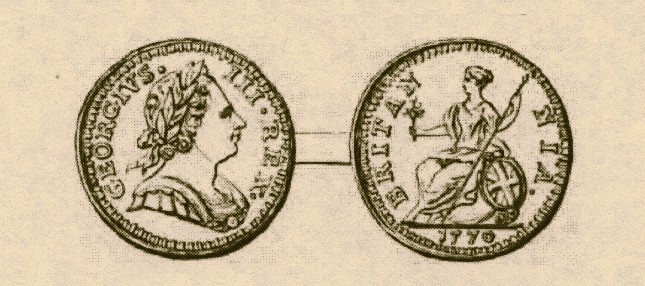
2. O. GEORGIVS. III. REX. The king's bust as on the halfpenny.
R. BRITANNIA. Figure as usual. Date in exergue. R. 1.
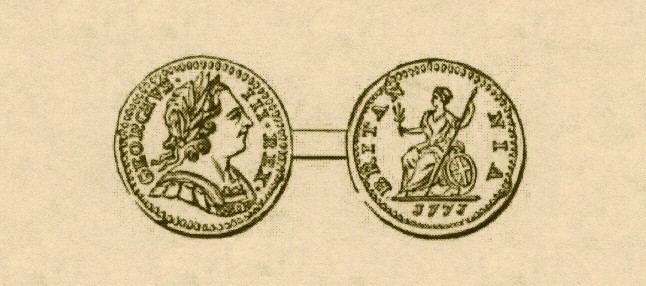
3. O. GEORGIVS. III. D: G. REX. on a broad band in sunk letter. The king's head to the right, laureate
and draped: under the shoulder is a small K, followed by three pellets triangularly arranged.
R. BRITANNIA. on a broad band as before. Britannia seated on a rock, the usual shield,
but with heraldic colouring, by her side, waves beneath; to the right a distant ship with three masts. On the rock
are three pellets triangular placed. In her right hand, Britannia holds an olive branch, in her left a trident. Beneath
the shield is the word SOHO On the band, below, is the date 1797. R. 2.
4. O. and R. Same as No. 3. R. 2.
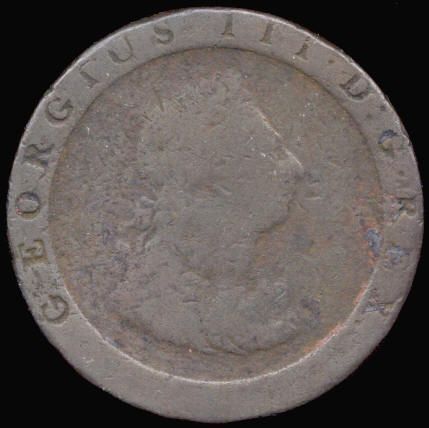
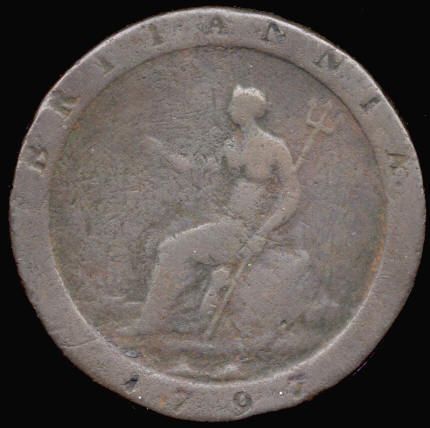
5. O. and R. same as No. 3, except that there are no pellets after the K under the king's shoulder. R. 4.
6. O. and R. same as No. 5, but the three pellets on the rock on the reverse are sometimes absent. R. 3.
7. O. GEORGIUS III DEI GRATIA REX The king's bust to the right, laureate and draped; under the shoulder
a pellet.
R. BRITANNIA. Figure as before, and with three pellets on the rock; under the shield,
SOHO. In the exergue, 1799. R. 1.
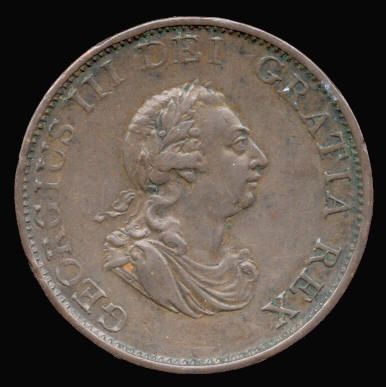
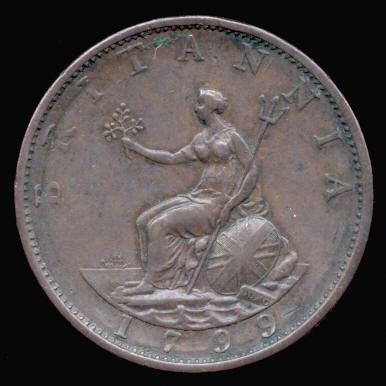
8. O. GEORGIUS III DEI GRATIA REX The king's bust to the right, laureate and draped. Under it, the
date 1799.
R. BRITANNIA. The figure as before but with one pellet only on the rock. Beneath it
1 FARTHING between two rosettes.
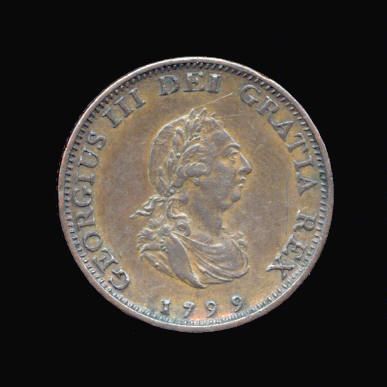
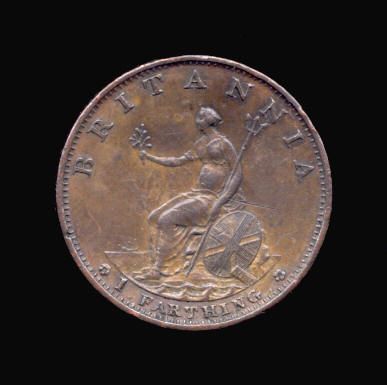
9. O. GEORGIUS III. D: G. REX. The king's bust to the right, laureate and draped, with the letter
K followed by a pellet under the shoulder. Beneath the bust, the date.
R. BRITANNIA. The usual figure with SOHO and with a small K
on the ground between the head of the trident and the shield. R. 1.
10. O. and R. As the penny and bearing the same dates. R. 1.
11. O. and R. Also as the penny and bearing the same dates. R. 1. One example of 1806, formerly in my collection,
had a pellet instead of K under the shoulder.
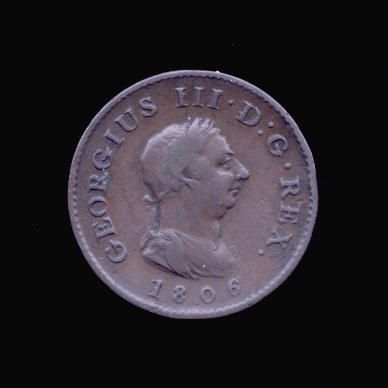
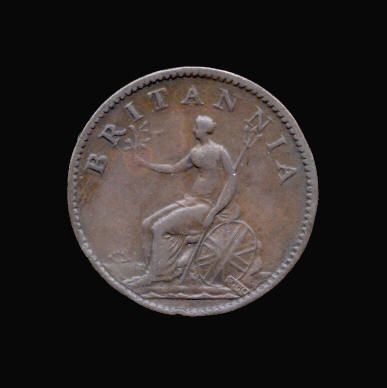
1. O. GEORGIUS III. D. G. REX. The king's bust to the right with long flowing hair, with a curl over
the shoulder, and bare neck, prolonged to the margin of the coin; D. F. (for Droz Fecit) on the shoulder.
An eagle's head above a thunderbolt beneath the bust.
R. BRITANNIA 1788. The date in the legend. Britannia seated on the globe, with flowing
robes which have richly emboidered edges; in her right had, a spear; in her left, a garland. The left arm rests upon a
shield. Under the shield, a small D. In the exergue, a ship's rudder and palm branch crossed. R. 7.
2. O. As No. 1, but the neck of the king much shorter. The eagle's head does not make its appearance on this and the
subsequent patterns.
R. As No. 1. R. 2.
3. O. and R. As before. On the edge, RENDER TO CESAR (sic) THE THINGS WHICH ARE CESAR'S.
R. 2.
4. O. and R. As before, but no D. F. on the shoulder. The hair is differently arranged, and the neck of the
king is elongated, as in No. 1. The D is under the shield on the reverse. Edge, RENDER, &C.
R. 7.
5. O. and R. As the last, with the elongated neck and without letters under the bust or under the shield. The date
1788, is in the exergue, instead of in the legend. R. 8.
6. O. As No. 2, but the hair of the king is not so full and slowing and there is no curl on the shoulder, which most
often affords a distinguishing feature between Droz's patterns of 1788 and 1790. A flower at the end of the legend.
Under the shoulder, DROZ. F. in sunk letters.
R. BRITANNIA. Britannia on a globe, with right arm stretched out and the left resting
on the shield, holds a spear. Behind the shield is a laurel branch. Beneath, in the exergue, is the date 1790
between two small quatrefoils. Beneath the feet of the figure, and above the date to the left, is DR. F.
R. 2.
7. O. and R. As before, except that a flower occurs after the legend on the reverse and on the edge are the words,
RENDER TO CESAR THE THINGS WHICH ARE CESAR'S in raised letters. R. 2.
8. O. As before, but no hair at all under the bust, and instead of the lettering on the shoulder, DROZ. F.
entirely under the bust.
R. As before. Edge of guilloche pattern. R. 2.
10. O. GEORGIVS. III. REX. The king's bust in armour to the right, with a wreath of large laurel leaves,
wearing also the riband of the garter and an ermine mantle.
R. BRITANNIA. The figure full faced, in flowing robes. A large branch of laurel
in her right hand and a wand in her left hand; on the left is the shield and on the right a globe. In the exergue,
1788. R. 6.
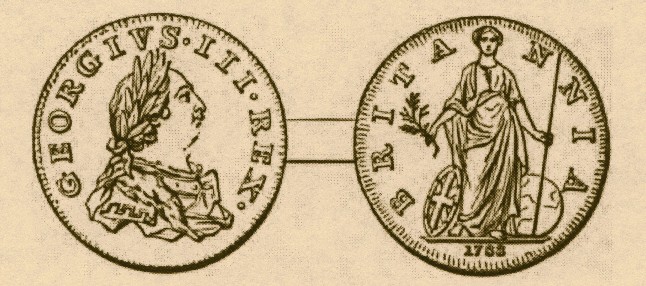
11. O. and R. As the above. R. 6.
12. O. GEORGIVS. III. REX. Bust of the king to the right laureate, and with bare neck; evidently copied from
Droz's design.
R. No legend. Britannia on a four-cornered stone behind which appears the head of a lion.
On the stone is depicted the usual shield. Britannia holds in her left hand a cornucopia, and with her right hand she
points to a large ship which is very near to her. In exergue, 1788. The whole surrounded by a wreath
of ears of wheat. Legend on edge ARMIS. TVTERIS. MORIBVS. ORNES. R. 7.
13. O. and R. Same as the last, but the legend on the edge is DO. AS. YOU. WOULD. BE. DONE. BY. R. 8.
15. O. GEORGIVS. III. DEI. GRATIA. Head of the king to left with very long and flowing locks and long neck,
bust in armour draped.
R. BRITANNIA. 1796.
16. O. GEORGIVS. III. D. G. REX. in sunk letters on a raised band. Below the head, on the band, SOHO
between two floral ornaments. The king's bust laureate, looking to the right, the neck bare, from Droz's die.
R. BRITANNIA. in similar letters between two floral ornaments. The figure as on
Droz's patterns. In exergue, 1795. The raised band is narrowed under the figure so as to allow space for the
whole design. R. 4.
17. In the National Collection is a halfpenny with the obverse of No. 16, and the reverse of the halfpenny of 1797
(Current Coin, No. 5). R. 8.
18. In the collections of Mr. Brice and others occurred a pattern in copper, with the obverse of the current halfpenny
of 1797 and with the reverse of No. 16. In my own collection was a similar variety in silver. R. 6.
19. O. GEORGIUS. III D: G. REX. Bust of the king much larger and broader than usual, to the right,
laureate. The neck bare. Under the shoulder, K sometimes followed by three pellets. Letters sunk as before.
R. BRITANNIA. 1797. Raised band and sunk letters. The figure is seated on a rock
washed by the waves. She holds in her right hand an olive branch, in her left a trident. Her left arm rests on a shield,
behind which is a rock. Under the latter is a small K. To the left is seen in the distance, a three-masted
ship. This is similar to the reverse of the circulating penny of 1797, but it has the K. instead of
SOHO under the rock. R. 4.
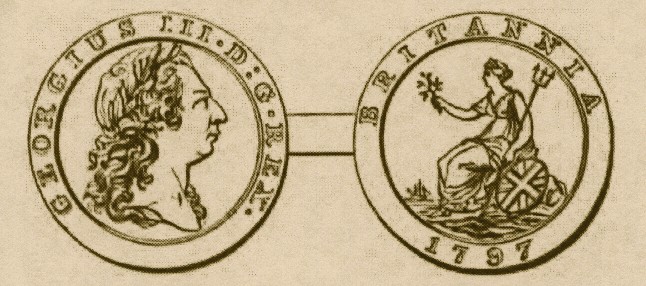
20. O. As before, but the lettering is much smaller.
R. As before, but the lettering is also much smaller, and the K. is under the
shield itself instead of under the rock. R. 7.
20A. O. As No. 20.
R. As No. 19, but with SOHO instead of K. I have seen cooper
and bronze examples of this variety, which may, probably, also claim a later date than the original pieces.
21. O. GEORGIUS III. D: G. REX. in sunk letters on a raised band. Under the head, on the band, two olive
branches between two roses bound by a riband, the upper portion of which forms a scroll on which are the letters
M. B. (for Matthew Boulton, the Director of the Soho Mint). The king's bust, which is to the right, is
draped. Under the shoulder, K, followed by three pellets in pyramidal form.
R. BRITANNIA. between two floral ornaments, in small lettering sunk as before.
Underneath are the olive branches as on the obverse,, but no roses, and in the inscription on the band is SOHO.
The helmeted figure is in flowing robes, and is seated on a globe, with a very large shield, under which is K
and from behind which issues a large olive branch, which she clasps with her left hand. In her right hand is the trident. A
three-masted ship in the distance. In the exergue, 1797. R. 5.
22. O. As No. 19.
R. As No. 20. R. 8.
23. O. As No. 20.
R. As No. 21. R. 7.
23B. O. As No. 21.
R. As No. 20 but no K. under the shield or rock.
24. O. As No. 21; but with no pellets after K.
R. As No. 20.
25. O. BRITISH COMMERCIAL PENNY. Bust of the king to the right, laureate, with bare neck and long flowing hair.
R. BRITANNIA. Figure seated on a gun carriage, on which the cannon is not wholly
depicted; the left hand is on the wheel, the right holds an olive branch. In the exergue, 1797. R. 4.
26. O. As the penny, except that HALFPENNY. is substituted for PENNY.
R. As the penny, but the whole of the cannon appear. R. 3.
27. O. As the penny, but QUARTER PENNY.
R. As the halfpenny. In the exergue to the right of the date is a small W. R. 3.
28. O. GEORGIUS III: D: G: REX. Bust of the king, of rather bolder work than, but closely resembling
No. 25, the neck dividing the date 17-99.
R. VIGEBIT | IN | OMNE | AEVUM. in four lines, in the field of the coin.
29. O. GEORGIUS III. D: G. REX. on a raised band in sunk letters. The king's bust laureate and draped to
the right. A small K under the shoulder. On the band beneath the bust, 1798.
R. BRITANNIA. in similar letters. The figure, with shield and rock behind, holding
in her right hand an olive branch, in her left a trident. Under the rock, SOHO. A ship in the distance.
On the band beneath the figure, 1 FARTHING. between two flowers. R. 5.
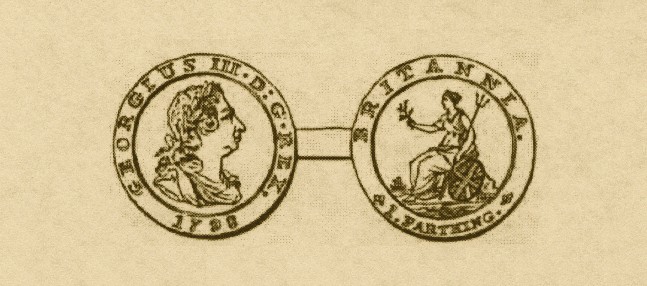
30. O. GEORGIUS III. D: G. BRITANN. REX. F. D. &C. Bust of the king to the right, laureate and draped,
resembling in all but very slight details that on the current coin, No. 7, but no K. under the shoulder.
R. BRITANNIA. 1799, as on the current coin, No. 7. R. 6. The edge is
slightly grained in the centre.
31. O. GEORGIUS III DEI GRATIA REX. Bust of the king to the right, resembling the last, but without the
laurel wreath and tye-knot. The head surmounted by the royal crown. K. (of a script character) under
shoulder.
R. As No. 30. R. 8. The edge is slightly grained in the centre.
32. O. and R. as No. 31, but the long curl across the neck is wanting, as also the curl appearing in front, over the
left shoulder, which is conspicuous on the preceding pattern to the right of the bust. The king's crown is much larger than
that on the preceding piece. Beneath the right shoulder is a lock of hair which does not occur on the preceding patterns.
The edge is plain or grained. R. 6.
33. O. GEORGIUS III. D: G. REX. and not DEI GRATIA, as on the current coin, No. 7, which it
resembles in every other resepct except that the hair and tye-knot are differently treated, and that there is a dot after
III, G, and REX, and two dots, perpendicularly placed, after D.
R. Same as current coin, No. 7. R. 8.
33A. O. GEORGIUS III DEI GRATIA REX. Bust of the king to the right, laureate and draped,
somewhat similar to the bust on the current halfpenny of 1799 (No. 7) but the wreath and hair are differently arranged.
The tye of the wreath at the back of the neck has but one end passing through a double bow, that on the current halfpenny
falls below a single bow. The K. is of a script character and is followed by three pellets.
R. BRITANNIA. Otherwise as the halfpenny of 1799, but no pellets after
SOHO, and the laurel branch is larger; the letters of the legend are closer together so that the trident
nearly touches the last stroke of the N instead of the first, as on the current piece. R. 5.
34. O. GEORGIUS III. D: G. REX. The king's bust to the right, laureate and draped. To the right a lock of hair,
falling over the left shoulder. Under the right shoulder, K.
R. BRITANNIARUM. The figure holds a large olive branch in her right hand, in her
left a trident. To the right of the shield, SOHO; to the left, K. In the exergue,
1805. R. 6.
35. O. and R. As the last. R. 6.
35A. O. Same as on No. 30.
R. Same as No. 35.
36. O. GEORGIUS III. D. G. REX. The king's bust as on No. 9 (Current Coins).
R. BRITANNIA. Figure as on No. 9 (Current Coins), but the date 1806
in the exergue. R. 8.
37. O. GEORGIUS III. D. G. BRITANNIARUM. REX. The king's bust laureate and draped.
R. BRITANNIA. The figure of Britannia, with the usual attributes.
37A. In my collection was a bronze pattern, identical with the current farthing of 1806 (No. 11) except
that the bust differs and resembles in all, but a few trifling variations in the arrangement of the hair and laurel
wreath, the current Irish farthing of 1806. It also differs from that farthing in having K. under the
king's shoulder. It has a plain edge.